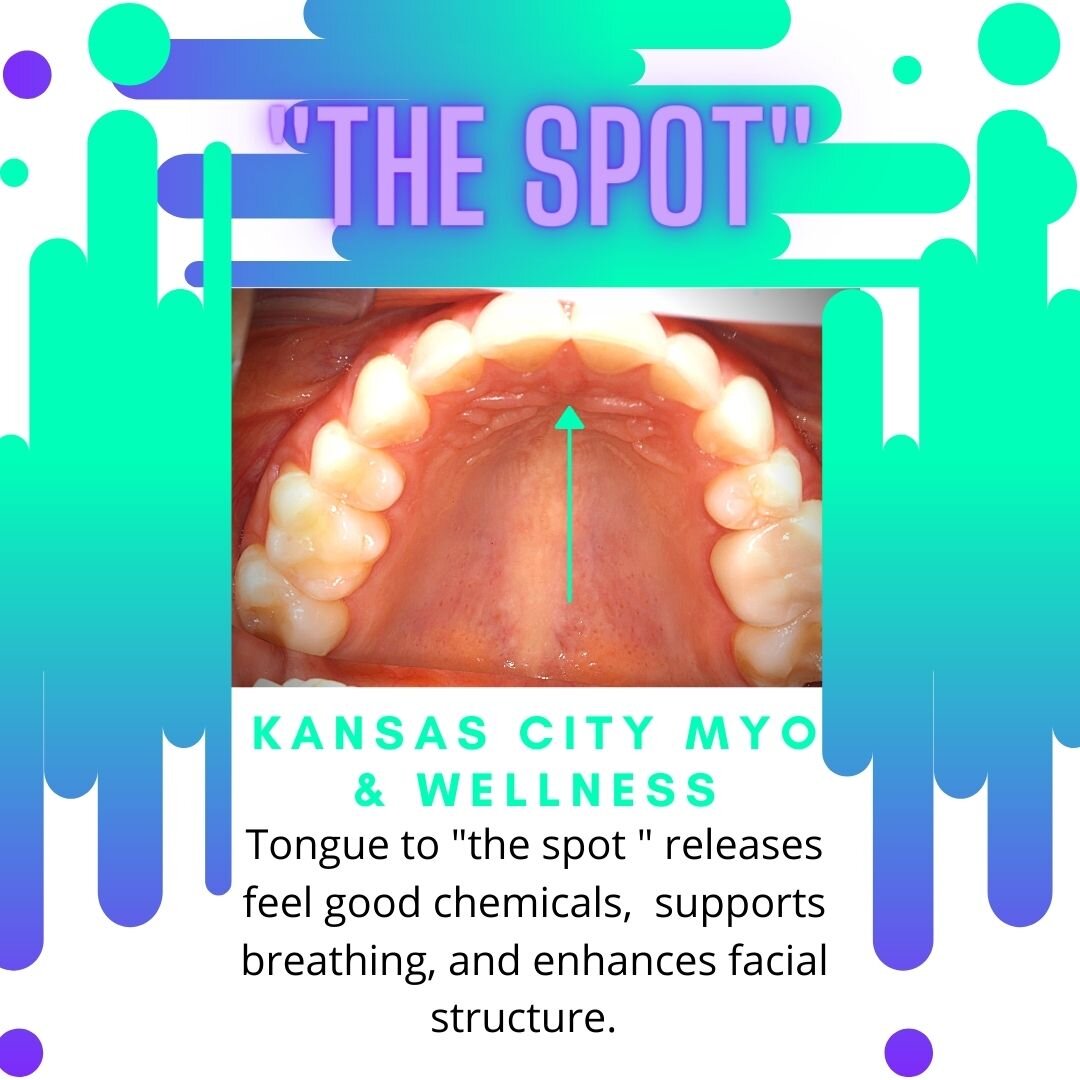Kansas City Myo & Wellness: orofacial myofunctional therapy, health coaching, and wellness. Breathe your best life and bloom.
The Role of Your Tongue
Your tongue plays a vital role in day to day eating, speaking, swallowing, and breathing. The way it functions during these actions and the way it rests within your mouth can have a huge impact on your health.
A proper oral rest posture includes:
lips sealed
nasal breathing
teeth slightly apart
tongue against the roof of the mouth (palate)
This rest posture promotes expansion and growth of the maxilla (upper dental arch) and palate through the gentle chronic force of the tongue. A wide palate/maxilla allows enough room for the permanent teeth and creates a healthy airway.
When the tongue is in a low floor of the mouth rest posture, the force gradually guides growth down and back creating a recessed chin, smaller jaws, and a narrower airway.
Over time this growth pattern can predispose a person to conditions like sleep apnea and upper airway resistance syndrome.
Resting your tongue on your palate with the tip on "the spot" stimulates feel good neurotransmitters serotonin, dopamine, acetylcholine, and norepinephrine (Dr. Antonio Ferrante), supports an open airway for optimal breathing, and enhances facial structure and body posture.
Common Signs of Dysfunction
SLEEP DISORDERS Snoring, teeth grinding/clenching, frequent wakening, tossing and turning, light sleep, insomnia, and bedwetting are some of the signs you are having difficulty breathing during sleep.
An improper rest posture of the tongue, weak muscles of the face, lips, tongue, and palate can contribute to the collapse of your airway during sleep leading to less time in the deeper restorative sleep cycles and higher risk of apnea.
Some structural conditions like a high narrow palate, small dental arches, tongue tie, removal of teeth for orthodontic treatment, enlarged tonsils/adenoids, etc create a higher risk of sleep apnea (OSA) or upper airway resistance syndrome (UARS).
Myofunctional therapy strengthens these weaknesses and addresses breathing to improve upon these issues in conjunction with other treatment modalities like cpap or airway growth guidance appliances.
POSTURE Often a forward head posture can develop as a breathing compensation for a small airway. Tightness of muscles and fascia can create imbalances as well.
HEADACHES Headaches, tmj, and neck pain result from poor posture, muscular tension, and sleep issues.
BEHAVIORAL ISSUES Poor sleep, a smaller airway, and mouthbreathing have been linked to ADHD and other behavioral problems. The symptoms of children who are tired parallel those of ADHD. Experts speculate that ADHD may actually be a result of a breathing/sleep problem. The following video shares one family’s struggle.
DIGESTION Insufficient chewing (we should chew each bite 20-40 times for better absorption of nutrients and feelings of satiety), aerophagia (swallowing of air), and poor swallow can lead to problems. If a tongue tie is present, it can be like having a resistance band in the mouth making chewing/swallowing more difficult.
ORTHODONTIC When the tongue doesn’t rest in the proper position and/or swallowing is dysfunctional, those forces can create challenges while in orthodontic treatment. This can mean a longer time in braces and higher risk of relapse when treatment is complete.
BEDWETTING Prolonged bedwetting can be a red flag for a sleep/breathing disorder. Bladder control is inhibited if the brain is using all its energy on delivering oxygen to the body. Establishing nasal breathing, a patent airway, and proper oral rest posture are essential steps for better sleep.
SPEECH It’s no surprise that the tongue plays a key role in speaking. The ability to produce sounds can be effected by impairment of the orofacial complex (lips, tongue, & facial muscles.)
DENTAL CAVITIES Tight lips can make it hard to brush areas like the front teeth, a restricted tongue makes it hard to sweep food off the teeth, improper swallow/chew habits may lead to leftover food in the mouth; all of which can make oral hygiene difficult. Mouthbreathing is another concern as it can create a dry mouth and high risk of dental decay.
PICKY EATING When a tongue tie is present or the tongue is not functioning like it should, gagging can easily occur which can make certain foods less palatable. If the lower jaw is set farther back, breathing and chewing capability are effected and aversions to some foods can develop.
MOUTHBREATHING An open mouth rest posture for mouthbreathing leads to weak lips, a low tongue posture, and underdeveloped jaws and facial structures. Mouthbreathing is detrimental not only for growth and development in a child, but overall health, focus, sleep and energy in both children and adults.
GROWTH & DEVELOPMENT An orofacial myofunctional disorder impacts the way we use our tongues, lips, and facial muscles. As a child grows the gentle forces of these muscles guide the development of the facial structure. Those forces can lead to a healthy forward growth with wide jaws, developed cheekbones, facial symmetry, open airway, and straight teeth OR they can lead to a recessed weak chin, narrow arches, malocclusion, inadequate airway, asymmetrical facial features. Poor facial development can lead to lifelong problems like sleep apnea and addressing them as soon as possible is vital.
BREASTFEEDING A poor latch, difficulty gaining weight, frequent feeds, hiccups, lip calluses, white coated tongue, reflux, and colic are examples of the numerous symptoms reported when a tongue tie is present. Breastfeeding is not only vital from a nutritional standpoint, but is also essential in shaping of the facial structures. A baby works the facial muscles, lips, and tongue when breastfeeding which guides the growth and development of the face, jaws, and airway. Most bottles easily deliver breastmilk or formula to the child which leads to underveloped structures due to underuse of facial muscles.
“I don’t think there is any doubt that tongue ties cause breastfeeding problems. And the reason is that it is key to achieve as good a latch as possible. A good latch results in pain free breastfeeding and the baby getting good flow of milk.”
Myofunctional Therapy trains the facial muscles, lips, and tongue to help with these symptoms.
Why do disorders occur?
Tethered Oral Tissues (TOTs)
The tongue and lips can be restricted in movement if the frenums (connective tissue underneath the tongue/under the lip) is too tight, short, thick, or restrictive. This tissue should resorb in utero, but for many it does not.
Thumbsucking, Sippy Cup or Pacifier use
A thumb/finger, sippy cup spout, or pacifier sits in the mouth where the tongue should rest (against the palate) forcing the tongue low in the mouth. This can lead to a lifelong low rest posture even after habits are discontinued.
Mouthbreathing
Frequent congestion can lead to the habit of mouthbreathing which requires a low rest posture of the tongue. The forces of a low oral rest posture guide the growth of the facial shape to create a vaulted narrow palate and smaller nasal cavity. Often tonsils and adenoids will become enlarged from mouthbreathing which makes proper nasal breathing more difficult. An open mouth rest posture will also lead to poor tone of the lips and facial muscles.
The above are just a few reasons why compensations of the facial muscles, lips, and tongue occur.
Have You Been Told You Have a Tongue Tie?
When you think of tongue ties (ankyloglossia), you may think of the more obvious ones like the image below.
These are the types that may be diagnosed at birth or by a pediatrician.
A tongue tie should be diagnosed based upon function, symptoms, and appearance.
When a less obvious tongue tie goes undetected, problems can occur.
Often if you have a tongue tie, you also have a lip tie (attachment of the upper or lower lip that restricts movement.) This tightness restricts movement and function and can impact the way your face grows and develops. The forces of the lips and tongue may prevent forward growth of the face resulting in an underdeveloped maxilla, smaller jaws, and narrower airway. These conditions can lead to lifelong struggles.
So what can you do about it?
An orofacial myology assessment is the first step in determining a plan for you or your child. Depending upon conditions and symptoms, a frenectomy (surgical release of tongue or lip frenums) may be indicated. Sometimes function and relief of symptoms may be achieved with therapy alone. Myofunctional therapy uses therapeutic exercises to train the lips, facial muscles, and tongue to work in harmony.
SOME THINGS YOU SHOULD KNOW ABOUT TONGUE TIE RELEASES
Typically the procedure is performed using only local anesthesia/numbing and is over within minutes.
If a frenectomy is recommended, myofunctional therapy is needed before and after the procedure.
Therapy before stretches the tissue to allow for better access for the provider performing the frenectomy. Muscles are also strengthened to promote function once restriction has been lifted.
Therapy after continues to gently stretch the tissue to prevent reattachment as the area heals. Goals are establishing a proper oral rest posture, chew/swallow, and nasal breathing.
“Working with a myofunctional therapist should ideally be a part of every release to retrain the tongue muscles and complex oral patterns to establish normal resting positions and goals of myofunctional therapy.”









